Head
The head is probably the most distinctive
feature of a Jindo.
By close examination of the head, experienced
judges can distinguish between a mix from a purebred and an average Jindo
from an exceptional Jindo.
Jindos |
Other breeds |

HwangSoon - photo by Jhun Kim |
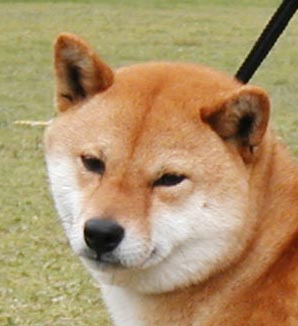
Japanese Shiba at a Beikoku Shiba Show
- photo by Ann Kim
|

Jindo at J.I. show - photo by Johnathan Lee
|
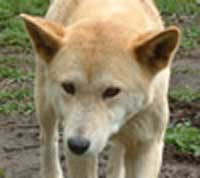
Australian Dingo- photo by Dingo Sanctuary
|

Jindo at J.I. show - photo by Johnathan Lee
|

young Japanese Kishu - photo by Mr. Rene Hesselman |
Impression and Presentation
The overall impression of the head is that
of polite and yet attentive cheerfulness.
Like the wolf, the Jindo's natural
head carriage when moving is lowered instead of raised.
Proportions
The size of the head must be in good proportion
to the body and should not look heavy or too small. Taken in context
with the rest of the body, the head length must not be too short or too
long. What this means is that for dogs of the leaner/longer body
style, often referred to as heutgae, the head would be longer. For
dogs of the thicker/stockier body style, often referred to as gyupgae,
the head would be shorter and more powerful.
The occiput (top part of the skull) to
snout ratio has a great deal of variance. However, the preferred ratio seems to be 6:4. (Longer occiput than snout).
General Shape
Many people describe the shape of the head
as appearing similar to an inverted triangle when viewed from above.
Hyungwon Kang has a good top view of this description on his site.
The picture is a bit fish-eyed, but the triangular impression is there.
http://www.kang.org/sajin/Jislandred2.GIF
Some people oppose the term triangular
as it gives the impression that the cheeks and cheek hairs (ie. "tiger-mane")
are flatter instead of abundant and full. Also, the term triangular
might imply a snipey or pointy muzzle which is not desired.
When viewed from the front, the desired
head is described as a circle or a dome. This is because of
the rounded and broad space between the ears as well as the rounded shape
given off by the cheeks and cheek hairs.

male
photo by Woo, Mu Jong
|

male
photo by Jhun Kim |

male
photo by Im, In Hak |
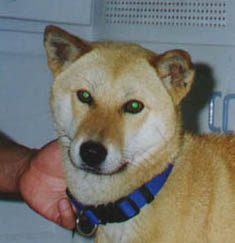
female
photo by CA shiba rescue |
Octagonal has also been used to describe
the Jindo head shape when viewed from the front, but one has to keep in
mind that it does not strictly refer to an equilateral or a straight-edged
octagon.
On a bit of a tangent, it's said that a
dog could have the same basic head shape as a Jindo, but it does not necessarily
make the dog into a Jindo. For instance, one difference said
to be between the Jindo and the Kishu is that a Jindo's cheeks are supported
by bone and not just muscles and fat. A Kishu could be described
as having a less pronounced underjaw than a Jindo. With Jindo-Kishu
mixes, the overall shape of the cheeks might look the same, but the substance
is different.
Sexual Dimorphism
Differences between male and female Jindos,
especially adults, should be noticeable immediately. The male typically
has a wider forehead, cheeks, and muzzle while the female has a more angular
look. Males also seem to have a stronger brow than females.
This contributes to the "wild" and "strong" appearance of the male while
giving females the "graceful" and "slender" look...most of the time.

The left is a male, the
right is a female.
diagram from the Korean
Jindo Dog Centrel Committee Association
Another generalization is that a female's
snout gives the impression of being longer than a male's snout. (Due
to the male's stronger bones.) This generalization only works when
comparing dogs within similar types. For instance, comparing a gyupgae
female with a heutgae male would not work.
Mother & Son comparison |

JinSoon - adult mother
photo by Ann Kim
|

Caesar - 1 year old son
(notice the stronger brow
on the son)
photo by Ann Kim |
Father & Daughter comparison |

PiPi - father
(notice the wider muzzle)
photo by Woo, Mu Jong? |

PiRu - daughter
photo by Woo, Mu Jong |
The Topskull and Stop
The single furrow on the forehead should
not be too deep and there should be no wrinkles on the forehead.

Coco (female)- photo by Ann Kim |

female - photo by Ann Kim
|
Many people find a rounded topskull and
backskull highly desireable on Jindos.

ChoRong (female)
photo by Johnathan Lee
Note the roundness of her
topskull.
|
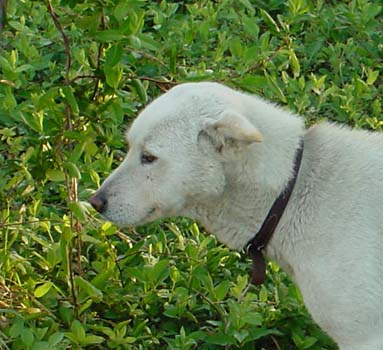
BaekChul (male)
photo by Johnathan Lee
|
If one examines the profile of the head,
the snout should be close to parallel to the top of the skull. (I
say close because the roundness of some dogs' heads can throw off the topskull
line.) One Jindo organization limits the perpendicular distance between
the snout and the skull to 2 cm.

diagram from the Korean
Jindo Dog
Centrel Committee Association |

Tygon (female)
photo by Jhun Kim |
In other words, Jindos should not have
an abrupt stop, but a moderate one with a gentle curve from the top of
the muzzle to the forehead. The brows seems to be a bit stronger
in males than females but the desired stops are unchanged. Overly
flat heads with no stops are not desired.
Muzzle and Mouth
Viewed from the side, the occiput is longer than the muzzle. The desired proportions
seem to be 6:4. Viewed from the front, the muzzle looks more round
than angular and tapers smoothly to a point from the stop to the nose.
Lips are black, even in white coated dogs. The lips should be tight. Loose lips
will give the dog weaker biting power, which is not good for hunting.
There is also a possibility of the dog fanging himself during a struggle.
In addition, loose lips give the dog an unhappy face instead of the cheerful
expression characteristic of a Jindo.
The palate is dark purple, almost black,
but the tongue should be large and deep pink without any spots. Most
people believe that tongue spots are indicative of Chow-Chow mixed in,
but some think otherwise. This minority believe only purple spots
with blurry edges are the ones indicating Chow-Chow mixes. In any
case, both groups consider any tongue spots undesirable.
The bite should be a scissor - upper front
teeth slightly in front of the lower teeth. All 42 teeth should be
present.
Ears
The ears are upright and have a triangular
shape. There are some dogs with "cow ears" or horn ears - ears that
curve out on the outside edge and in on the inside edge. These type
of ears are considered undesirable. Ears that are only curved on
the outside edge but with a straight inside edge are considered acceptable.
Ear size should have be in good harmony
and balance with the face (ie. dogs with longer muzzles would be expected
to have somewhat larger ears). The ears are thick and yet are capable
of nimble movement. They have ample inner hair. From
a front-view, the tips are rounded rather than coming to a sharp point.
The ears normally rest slightly outward, but will move more up when the
dog is alert. The angle the ears points have been compared to the
hands on a clock. When at rest, the ears would be at 10:10.
When alert, the ears would be at 11:05. Nimble movement and rotation
of the ears carry higher priority over static ear positioning though.
The space between the ears should be broad
and rounded.
From a side-view, ears are pricked forward
past vertical. The ears lean forward, continuing the line of the
neck. This ear position is described as hooded rather than erect.
(Some of the other nordic breeds have erect ears instead of hooded ears.)
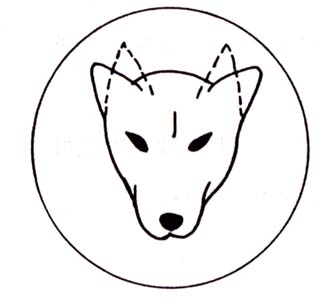
diagrams from the Korean
Jindo Dog Centrel Committee Association
|

diagrams from the Korean
Jindo Dog Centrel Committee Association |

Caesar (young male) - photo by Ann Kim
|

SoonHei (female) - photo by Ann Kim
|
Puppies have downward pointed ears for
approximately 5 months. The base of the ear might solidify prior to that,
but typically, a Jindo doesn't have fully upright ears until 6 months of
age. Ears typically grow faster than the skull and so it's not uncommon
for youngsters to have an ungainly, over-sized look to them, but they can
grow out of it.
Different groups have different desired
timetables in which ears should lift. The KNDA mentions they should lift
at 3-4 months. Another book with a heavy emphasis on hunting, says they
should lift as late as 8 months of age. Why the contradiction?
Perhaps it has to do with the desired size
of the ear. The KNDA prefers small triangularly shaped ears that balance
the head, prevent chances of frostbite, and so it doesn't take long for
the ears to completely lift. Others believe that there is a correlation
between larger ears and hunting ability and thus desire the larger triangular
ears that would take much longer to lift.
Perhaps it has to do with the thickness of the ear leather? The thicker ear leathers are more desired but may take longer to lift.
This could be a harmless matter of difference
of opinion except for that fact that Koreans severely detest Jindos that
don't have fully upright ears. People who breed for large ears or thick ear leather sometimes
are faced with the possibility that the ears will never lift all the way or the ear shape is bent. In addition, the larger the ear, the less effective
the ear hairs are in protecting the ear from water/debri during a hunt.
For pups that have fully erect ears earlier
than 3 months of age, there might be some doubts about the purity (Japanese
breeds have their ears fully erect at a very early age, ~40 days), but
one has to look at the overall appearance and behavior of the adult dog
to be certain.
Eyes
See Eyes section
Nose
Black noses are required on colored dogs.
Flesh/pink noses are allowed on white dogs. Sometimes a white dog
may have a solid black nose as a puppy, but the color fades in the middle
to flesh/pink as the dog matures.
Nose Color in White Jindos |

Less Common - Solid black
|
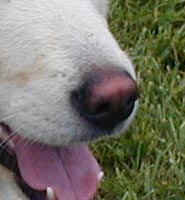
More Common - Pink nose rimmed with black |
Black skin pigment is desired in Jindos, but there is some debate on whether a black
nose on a white dog is a sign of Japanese Kishu Inu blood.
This opinion is still in the minority in light of the fact that history
indicates white dogs with black noses did exist.
The black nose on white Jindos seems to be restored when the white dog has some black/tan coat color genes,
but this isn't widely accepted yet.
9/24/05 UPDATE: There are some "yellow" Jindos that have brown pigment on their noses and
skin. Quite honestly, my feeling is that this shouldn't be considered
a feature indigenous to the Jindo population. The genetics behind
this color is quite possibly a Ay (agouti yellow) combined with the
recessive dilution gene called brown (or chocolate- or liver-) dilute.
(B = Black
factor gene, b = red factor gene)
One example of this in effect can be
seen in "red" Dobermans. Black fur is turned red-brown and black
skin pigment is replaced with a liver/brown/chocolate color.



























